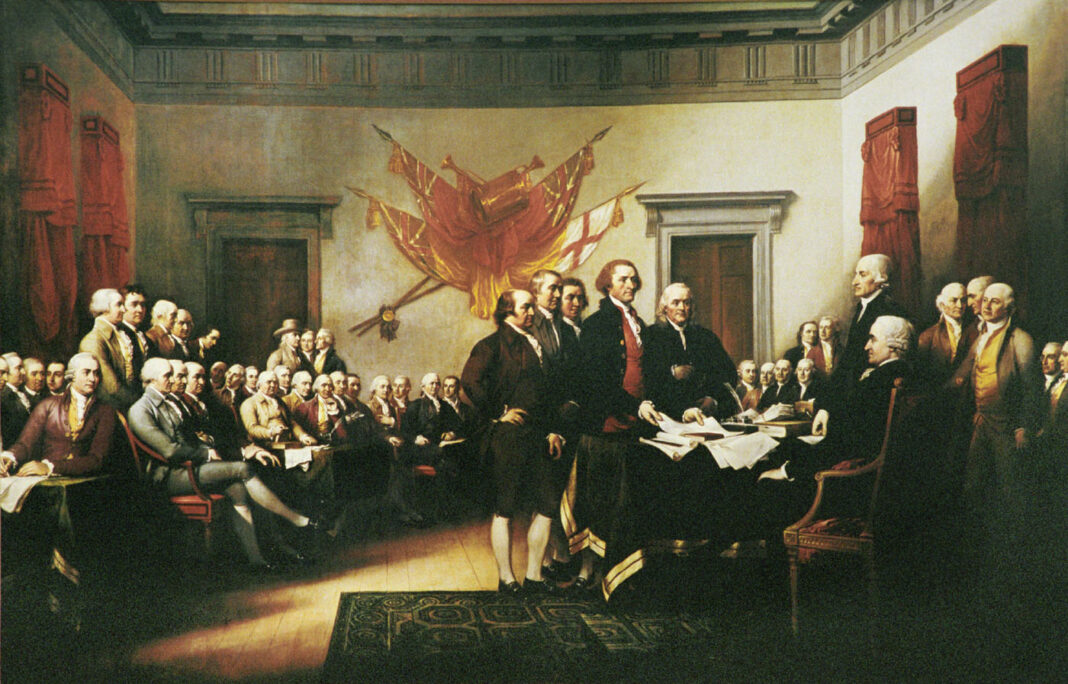We recall this curious story on the eve of July 4 (Independence Day, also commonly known as the Fourth of July, marks the date that the Declaration of Independence was adopted in 1776).
In 1959, the Smithsonian Institution received a letter from Mrs. James Wade offering to sell a linen flag with an ink image of an eagle bearing the portrait of the third President of the United States, Thomas Jefferson, triumphantly, framed in a halo of seven-pointed stars. his face has a ribbon on which he writes: “T. Jefferson, President of the United States. John Adams is no more.
Today, the flag, one of the few surviving artifacts from the 1800 U.S. election, is housed in the collections of the Smithsonian’s National Museum of American History.
But how did Mrs. Wade become the owner of such a significant part of American history? She says that in 1958, her 14-year-old son Craig and his 11-year-old brother Richard discovered the relic in a ditch next to a railroad track near Pittsfield, Massachusetts. The older son takes her home and hangs her on the wall of his bedroom. The family realized its importance only after the brothers took it to school to show it, and the teachers recommended that it be shown in a local museum.
The curators of the museum’s “Department of Political and Military History” have always wondered whether the story with the two boys is true or not. And one day they just decide to look for them on Facebook to ask them…
“I’m so amazed you found me,” said Craig Wade, who currently lives in Anchorage, Alaska. Sixty years after finding the flag on a dusty road during their summer vacation, Craig and Richard Wade are now retired soldiers.
Their memories of finding the flag are strikingly similar to each other, as well as to the evidence and information that curators find in their files and archives.
A year after the boys found the flag, the family consulted with experts from state history societies and professors at Harvard University. After a physical examination, they agree that the artifact is authentic and belongs to a museum. “All of us here [at the Massachusetts Historical Association] who saw Jefferson’s flag were convinced of its undoubted authenticity and considered it a truly remarkable object,” Lyman Butterfield, editor-in-chief of The Adams Papers, told the Smithsonian.
It is alleged that several institutions made suggestions to Ms. Wade before she contacted Smithon. The newspapers have since said that she was initially offered between $ 50 and $ 100, but in fact her find is difficult to estimate because it is incredibly unique.
In 1959, she told the Mansfield News and Times: “I don’t know whether to sell it to a museum or keep it. And if I have to sell it, do I have to get $ 100 for it, or $ 500, or $ 1,000? What is its price?
The Smithsonian receives the flag on a short-term loan. The museum staff makes their own review of the materials of the banner and agrees with the findings of other experts that the banner is really real. They turned to other institutions, including the Massachusetts Association of History, the University of Virginia, Princeton University and Monticello, to see if anyone was familiar with the site. Everyone is enthusiastic about the flag, but says they have never seen it.
To help acquire the flag, the museum turned to Ralph E. Becker, a lawyer in Washington and a big collector of the political American, who would eventually donate his collection to the Smithsonian. Using his political contacts, Becker arranged for Clarence Barnes, a former Attorney General of Massachusetts, to advise the Wade family in negotiations to sell the banner. Ms. Wade initially asked for $ 5,000, but eventually accepted Becker’s $ 2,000 offer (about $ 17,000 in today’s dollars) and in 1961 a final agreement was reached for Becker to personally purchase the banner and donate it to the museum.
Craig Wade remembers well the summer when he and his brother found the flag. He remembers that his mother sent them to stay with relatives for a while during the summer holidays – this would be a holiday for both her and the boys, who come from a family with ten children. “I was in 7th grade in Mansfield, Massachusetts. Our mother sent us in the summer, for a few weeks, to stay with Aunt Selma and Uncle George, who lived in Pittsfield, ”explains Wade.
Their great discovery comes when they walk one afternoon. “So we did what the kids did, you know, we walked to the railroad tracks in Pittsfield and there we saw a box. We saw a box next to the railroad tracks in the ditch, and I opened it,” This is cool”. My brother Ricky, he was throwing rocks or doing something else at the time, so I put it in my jacket and kept going… Did you know that we were walking on the side of the railroad tracks where we shouldn’t have been and I think it probably fell from a vehicle if I have to guess. Someone may have moved, ”Wade recalls.









